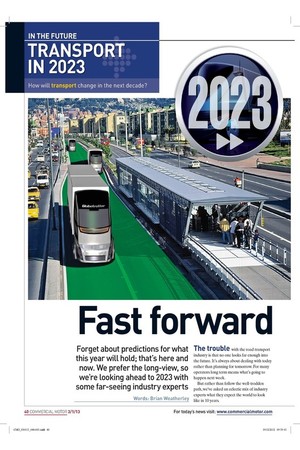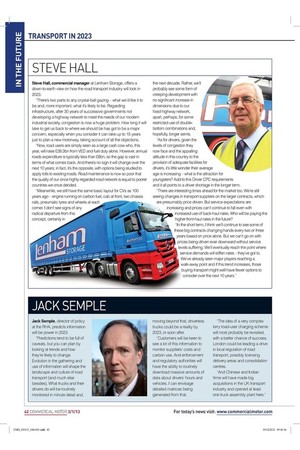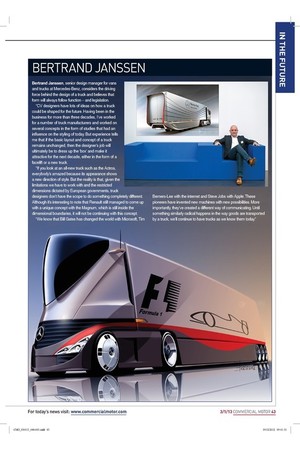Fast forward
Page 32

Page 33

Page 34

Page 35

If you've noticed an error in this article please click here to report it so we can fix it.
Forget about predictions for what this year will hold; that's here and now. We prefer the long-view, so were looking ahead to 2023 with some far-seeing industry experts Words: Brian Weathertey The trouble with the road transport industry is that 110 one looks far enough into the future. It's always about dealing with today rather than planning for tomorrow. For many operators long term means what's going to happen next week.
But rather than follow the well-trodden path, we've asked an eclectic mix of industry experts what they expect the world to look like in 10 years.
CARL JOHAN ALMQVIST Carl Johan Almqvist, traffic and product safety director at Volvo Truck Corporation, imagines himself in a very different industry 10 years from now. In 2023 platooning is becoming more popular among fleets that have several vehicles heading for the same destination, so letting one specially-trained driver in the lead truck be responsible for one or two following trailing trucks is common. Trials have also started with the 'trailing' vehicles being linked fullyelectronically, so without any drivers in the cab.
"Road conditions, as well as traffic flow input, are being continuously used in the truck so drivers are no longer surprised by adverse weather, road or traffic congestion. On ring roads and larger trunk roads support systems (vehicle-to-vehicle and vehicle-to-infrastructure) take full control of vehicles in dedicated lanes, so as to keep very short distances between them — but in a safe way because those systems control the vehicles' steering, engine and brakes. Vehicles are guarded by electronic 'fences', so pedestrians can feel safe when getting close.
"In 2023 seatbelts are still being used in trucks, but no driving can be done without the driver using them. However, the belts are 'smart' so they don't disturb the driver. At the same time they can be tensioned, if needed, before an accident or incident, automatically taking care of slack because of bulky clothes, thereby giving the driver maximum protection.
"And any inattention by the driver is continuously monitored so he/ she is alerted via the seat, steering wheel and safety belt to stay focused."
ASHLEY COGH ILL Veteran LGV wheelman and author of The Long Haul Pioneers, Ashley Coghill, who drives for Dave Watson Transport, wonders whether today's truck driving skills will still exist in 2023.
"As a professional truck driver with more than 30 years' experience, I'm dismayed by modern-day driving standards and I wonder if today's technology contributes to this. We now have lane assist, brake assist, electronic park brake, cameras, bleepers, reverse and side sensors and truck/driver monitoring systems, to name just a few. Everything's there to make the driver's job safer but also, surely, easier too.
"However, today's modern and young drivers know little about the vehicles they're charged with, or the mechanics of them.
"With powerful engines, quiet cabins, light and very responsive steering and all-round air 1/4 suspension that irons out every bump on the road, everything becomes effortless, which in turn lulls the driver into a false sense of security as he/she has no true feeling that the vehicle may be fully loaded and possibly very heavy.
"While I support such technology, I'm concerned that if anything was to fail, then the driver won't know what to do. So, by 2023, I'd like to see regular driver-refresher training with a strong emphasis on traditional driving skills.
"This needs to start now because in 10 years' time, those traditional, hard-earned, common-sense skills may well be extinct."
STEVE HALL Steve Hall, commercial manager at Lenham Storage, offers a down-to-earth view on how the road transport industry will look in 2023.
"There's two parts to any crystal-ball gazing — what we'd like it to be and, more important, what it's likely to be. Regarding infrastructure, after 30 years of successive governments not developing a highway network to meet the needs of our modern industrial society, congestion is now a huge problem. How long it will take to get us back to where we should be has got to be a major concern, especially when you consider it can take up to 15 years just to plan a new motorway, taking account of all the objections.
"Now, road users are simply seen as a large cash cow who, this year, will raise £38.3bn from VED and fuel duty alone. However, annual roads expenditure is typically less than £8bn, so the gap is vast in terms of what comes back. And there's no sign it will change over the next 10 years; in fact, it's the opposite, with options being studied to apply tolls to existing roads. Road maintenance is now so poor that the quality of our once highly regarded road network is equal to poorer countries we once derided.
"Meanwhile, we still have the same basic layout for CVs as 100 years ago — engine running on carbon fuel, cab at front, two chassis rails, pneumatic tyres and wheels at each corner. I don't see signs of any radical departure from this concept, certainly in the next decade. Rather, we'll probably see some form of creeping development with no significant increase in dimensions due to our fixed highway network, apart, perhaps, for some restricted use of doublebottom combinations and, hopefully, longer semis.
As for drivers, given the levels of congestion they now face and the appalling attitude in this country to the provision of adequate facilities for drivers, it's little wonder their average age is increasing — what is the attraction for youngsters? Add to this Driver CPC requirements and it all points to a driver shortage in the longer term.
"There are interesting times ahead for the market too. We're still seeing changes in transport suppliers on the larger contracts, which are presumably price driven. But service expectations are increasing and prices can't continue to fall even with increased use of back-haul rates. Who will be paying the higher front-haul rates in the future?
"In the short term, I think we'll continue to see some of these big contracts changing hands every two or three years based on price alone. But we can't go on with prices being driven ever downward without service levels suffering. We'll eventually reach the point where service demands will stiffen rates — they've got to. We've already seen major players reaching a walk-away point and if this trend increases, those buying transport might well have fewer options to consider over the next 10 years."
JACK SEMPLE Jack Semple, director of policy at the RHA, predicts information will be power in 2023.
"Predictions tend to be full of caveats, but you can plan by looking at trends and how they're likely to change. Evolution in the gathering and use of information will shape the landscape and culture of road transport (and much else besides). What trucks and their drivers do will be routinely monitored in minute detail and, moving beyond that, driverless trucks could be a reality by 2023, or soon after.
"Customers will be keen to see a lot of this information to monitor suppliers' costs and carbon use. And enforcement and regulatory authorities will have the ability to routinely download massive amounts of data about drivers' hours and vehicles. I can envisage detailed matrices being generated from that.
The idea of a very complex lorry road-user charging scheme will most probably be revisited, with a better chance of success. London could be leading a drive in local regulation of road transport, possibly licensing delivery areas and consolidation centres.
And Chinese and Indian firms will have made big acquisitions in the UK transport industry and opened at least one truck assembly plant here."
BERTRAND JANSSEN Bertrand Janssen, senior design manager for vans and trucks at Mercedes-Benz, considers the driving force behind the design of a truck and believes that form will always follow function — and legislation.
"CV designers have lots of ideas on how a truck could be shaped for the future. Having been in the business for more than three decades, I've worked for a number of truck manufacturers and worked on several concepts in the form of studies that had an influence on the styling of today. But experience tells me that if the basic layout and concept of a truck remains unchanged, then the designer's job will ultimately be to dress up the 'box' and make it attractive for the next decade, either in the form of a facelift or a new truck "If you look at an all-new truck such as the Actros, everybody's amazed because its appearance shows a new direction of style. But the reality is that, given the limitations we have to work with and the restricted dimensions dictated by European governments, truck designers don't have the scope to do something completely different.
Although it's interesting to note that Renault still managed to come up with a unique concept with the Magnum, which is still inside the dimensional boundaries, it will not be continuing with this concept.
"We know that Bill Gates has changed the world with Microsoft, Tim Berners-Lee with the internet and Steve Jobs with Apple. These pioneers have invented new machines with new possibilities. More importantly, they've created a different way of communicating. Until something similarly radical happens in the way goods are transported by a truck, we'll continue to have trucks as we know them today"









































